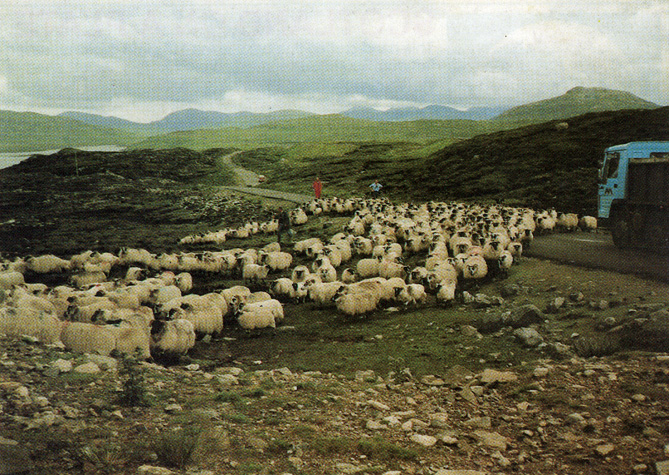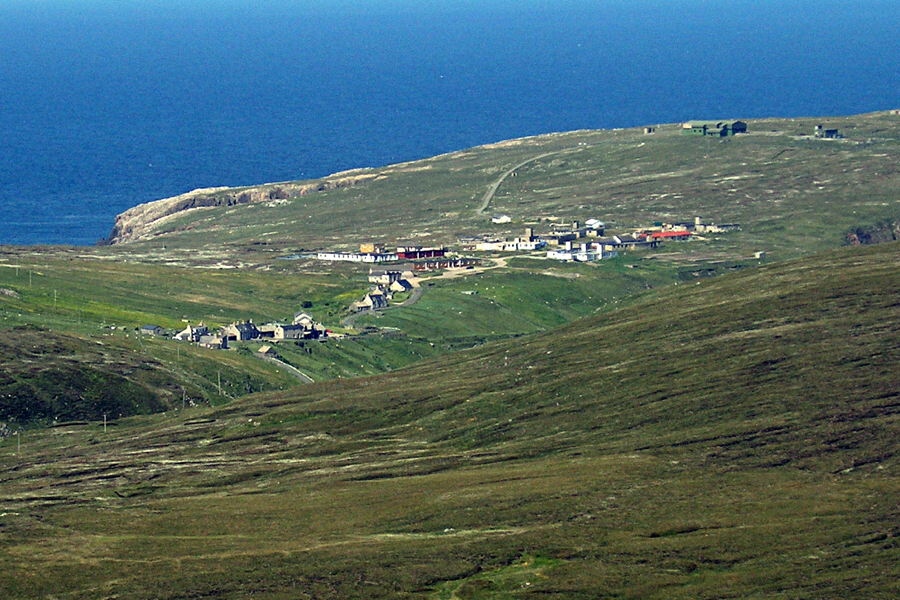Category: Crofting (page 2)
A Treat for a Cold Friday: Uig, 1964-65
The Gathering

This account of the gathering of the sheep into the Gisla fank for the clipping was written by David Henderson and first published in the Scots Magazine in August 1995. These large-scale community gatherings are now, sadly, a thing of the past. There are more pictures in the gallery, and of the fank at Loch Suainebhat here.
In the diffuse crofting culture of the Western Isles, the summer gathering of the sheep from the moors is one of the main highlights of community life. The practice has remained virtually unchanged since the arrival of the sheep in Lewis, and is a ritual I, as an incomer on holiday from Musselburgh, was priviledged to take part in. The gathering made the highlight of my stay.
My uncle Jim and I woke at dawn. The weather looked poor – drizzle and mist hid the view of Loch Roag from the kitchen window. I was sure the gathering would be put off – wet weather meant damp fleeces, difficult clipping and hours of drying for the Blackface wool we were to harvest.
Donald Calum Morrison, our crofting friend from Valtos, arrived at 7am as planned, refusing tea and looking skyward. “It looks awfully dull,” he said, “but no one’s phoned me so the gathering’s still on.”
Soon I was huddled in the back of Donald Calum’s austere van, sharing floorspace with an excited sheepdog who seemed to know what was in store. We rattled and bounced down the single track road, through Miavaig and on to the road south, pulling into passing places from time to time for a competing car, Donald Calum waving to them with the easy grace of one used to the island etiquette. Then we reached Gisla for the start of the walk into Morsgail Forest, a barren moor between Lewis and Harris where the Valtos crofters’ sheep roam their common grazings.
More than a dozen cars were gathered there. A brief discussion took place in the rain. All the crofters were annoyed that the weather had closed in – during the fortnight before, it had been “just like the Sahara,” as one local put it. There were pensive faces, shaking heads, pursed ips and whistling through teeth. “If it doesn’t dry up soon, the wool will be soaked,” said one man.
Gisla Fanks, 1990-1995
Grievances Told to the Napier Commission
When the Geshader Bull Was Drowned
Going to the Shieling
From left, Emily Macdonald Gisla, Effie Maclennan 36 Cliff, and two visitors, visiting a shieling.
From Emily’s Twenty Years of Hebridean Memories (1939) – observing from Gisla Lodge the girls going to the shielings at Airigh an Fhorsa and Bo Nighean Mhuirich. The ones Emily mentioned visiting near Loch Coirgeabhat may be at Airigh an Uisge.
Crogabhat, one of our fishing lochs, is a mile from the bungalow, and there we constructed a concrete boathouse which is useful as a lunch hut too when it is cold or wet. About a mile beyond it are two shielings to which we occasionally make an expedition. Shielings are small huts of stone and turf, where girls live for six weeks in the summer while herding the village cattle, brought there to feed on the fresh hill grass of the surrounding moor. This serves a doubt purpose, as it gives the grass round the village a chance to grow, while at the same time the cattle are getting the benefit of moorland feeding. The shielings are often as far as ten miles from the villages, and the day of migration thence is full of excitement.
Of course, we at Gisla can only guess at all the bustle of preparaton that must have gone on since the early morning, but any time after midday the first of the precession begins to pass the bungalow. Groups of cattle of various sizes pass by, accompanied by old women and young girls, and dogs anxiously helping them with the herding. These all turn on to the moor just beyond the boundary of our garden, and there the humans sit down to rest and await their friends still on the road, while the cattle begin to browse, and the dogs fuss around and interest themselves in canine affairs.
After a while, a couple of boats can be seen coming up the loch, and we rush down to the shore to see the unloading. In them are the men, with a miscellaneous collection of bedding, stools, milking pails, churns, meal bags, pots, kettles and all the paraphernalia required for a stay of some weeks on the moor. Also a number of calves too young to walk the whole distance with their mothers and of course more dogs. After leaving the boats, the men load the good into creels which they carry on their backs, and joining the women folk who have already arrived, the whole procession starts off for the distant shielings. There are four lots in Uig [by this stage, when they were falling out of use], and these people I have just described have a much longer way to go than those occupying the sheilings we sometimes visit.
Peigi an Irish and Morgan
Babag and Peggy Ann at the Peats
Aird Uig in 1959
A chapter from Uig, a Hebridean Parish (1960) by Madge Phillips.
The little township of Aird is an isolated and old-established crofting settlement along the western side of the steep and narrow valley of the Amhainn Gil na h-Airde three miles north of Crowlista. After leaving Loch Meacheit, the river flows northward through a gorge (at the mouth of which are the ruins of the old corn-mill) then across a narrow flood-plain into the rocky bay of Camus na h-Airde. The crofts, roughly fan-shaped in arrangement and varying in size from 3 3/4 to 7 acres, each originally included a narrow strip of the flood-plain, stretchng across from just beyond the right bank of the river, up the steep, rocky slope above the left bank and widening out over the more gentle slopes between the 100′ and 200′ contours. A number of the crofts were subsequently enlarged, gaining extra land on the right bank of the stream, whilst others received additional ground to the north or south.
The 1700 acres of common pasture stretch to the east and west of the crofts, across the peninsula which terminates in Gallan Head, extending to those of Crowlista and Valtos in the south. The whole coast is broken and rocky, the land inland is peaty, and Aird lacks the advantages of the machair land found further west. To the north of the village there is now an RAF radar station on Rudha Caol, built on what was part of the common pasture. It dominates the landscape and makes a considerable difference to the life of the inhabitants.
The township, though isolated, is reached by a good road which leaves the main road at the western end of Glen Valtos. Grocery vans call on Wednesday and Friday, a butcher’s van on Saturday, and the local people are also allowed to shop at the NAAFI within the Camp. The road through the village approximately follows the line of the 100’ contour and all the houses are built directly on to the road, with byres, weaving sheds and other buildings behind, whilst in most cases hens are kept on the steeper slopes below the road. The majority of the houses are stone with slate roofs and fairly large, though some of them have been built for more than fifty years. All have electric light and their own water supply and several have modern byres.



